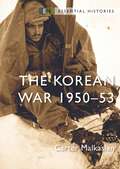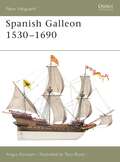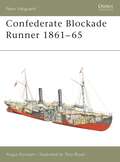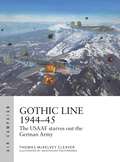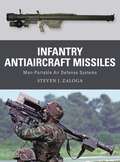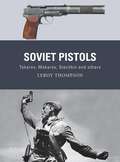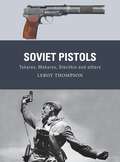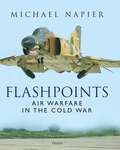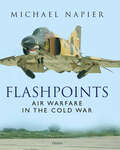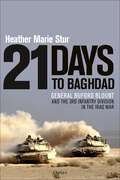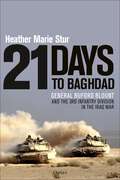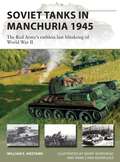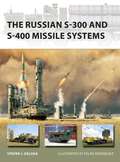- Table View
- List View
The Korean War: 1950–53 (Essential Histories)
by Carter MalkasianIn this fully illustrated introduction, Dr Carter Malkasian provides a concise overview of the so-called "Forgotten War" in Korea.From 1950 to 1953, the most powerful countries in the world engaged in a major conventional war in Korea. Yet ironically this conflict has come to be known as the USA's "Forgotten War." Esteemed historian Dr Carter Malkasian explains how this conflict in a small peninsula in East Asia had a tremendous impact on the entire international system and the balance of power between the two superpowers, America and Russia. In this illustrated history, he examines how the West demonstrated its resolve to thwart Communist aggression and the armed forces of China, the Soviet Union and the United States came into direct combat for the only time during the Cold War. Updated and revised for the new edition, with specially commissioned color maps and new images throughout, this is a detailed introduction to a significant turning point in the Cold War.
Spanish Galleon 1530–1690 (New Vanguard)
by Angus KonstamDuring the middle decade of the 16th century a new type of sailing vessel emerged, designed to carry the wealth of the Americas to Spain. This was the galleon, and over the next century these vessels would serve Spain well as treasure ships and warships, becoming a symbol of Spanish power and wealth during the period. The development and construction of the Spanish galleon are discussed in this book, and the ordnance and crewing needed to produce and maintain these stately vessels is covered. The author also examines the role of the galleon as a treasure ship, and describes how these ships were manned and fought in action.
Confederate Blockade Runner 1861–65 (New Vanguard)
by Angus KonstamThe lifeblood of the Confederacy, the blockade runners of the Civil War usually began life as regular fast steam-powered merchant ships. They were adapted for the high-speed dashes through the Union blockade which closed off all the major Southern ports, and for much of the war they brought much-needed food, clothing and weaponry to the Confederacy. This book traces their operational history, including the development of purpose-built blockade running ships, and examines their engines, crews and tactics. It describes their wartime exploits, demonstrating their operational and mechanical performance, whilst examining what life was like on these vessels through accounts of conditions on board when they sailed into action.
Confederate Blockade Runner 1861–65 (New Vanguard)
by Angus KonstamThe lifeblood of the Confederacy, the blockade runners of the Civil War usually began life as regular fast steam-powered merchant ships. They were adapted for the high-speed dashes through the Union blockade which closed off all the major Southern ports, and for much of the war they brought much-needed food, clothing and weaponry to the Confederacy. This book traces their operational history, including the development of purpose-built blockade running ships, and examines their engines, crews and tactics. It describes their wartime exploits, demonstrating their operational and mechanical performance, whilst examining what life was like on these vessels through accounts of conditions on board when they sailed into action.
Fair Oaks 1862: McClellan’s Peninsula campaign (Campaign)
by Angus KonstamFollowing its humiliating defeat at the First Battle of Bull Run, General George B. McClellan took command of the Union Army of the Potomac. In the spring of 1862, having rebuilt his forces, the "Little Napoleon" devised a plan to end the war in a single campaign. Transporting his army by sea to the Virginia Peninsula, he would outflank Confederate forces and march unopposed on Richmond, the Southern capital. Excessive caution squandered the opportunity, however, and on 31 May the Confederates struck at McClellan's divided forces at Fair Oaks. This book details McClellan's controversial Peninsula campaign and the southern attempt to halt the Union juggernaut.
Fair Oaks 1862: McClellan’s Peninsula campaign (Campaign)
by Angus KonstamFollowing its humiliating defeat at the First Battle of Bull Run, General George B. McClellan took command of the Union Army of the Potomac. In the spring of 1862, having rebuilt his forces, the "Little Napoleon" devised a plan to end the war in a single campaign. Transporting his army by sea to the Virginia Peninsula, he would outflank Confederate forces and march unopposed on Richmond, the Southern capital. Excessive caution squandered the opportunity, however, and on 31 May the Confederates struck at McClellan's divided forces at Fair Oaks. This book details McClellan's controversial Peninsula campaign and the southern attempt to halt the Union juggernaut.
The Forts of Celtic Britain (Fortress)
by Angus KonstamHalf a millennium before the Romans first arrived in Britain, an even more ferocious people, the Celts, arrived in what is now south-eastern England. The Celts remained in Britain long after the Romans departed, and although driven into the remoter corners of the island by English invaders the people who remained clung onto their Celtic heritage, and defended their remaining lands against all-comers. In order to defend their lands from other tribes or outside invaders these people established powerful fortified sites that served as places of refuge in wartime and as administrative and trading centres in times of peace. This book examines these fascinating forts, which varied considerably from the mysterious brochs and duns found in northern Britain, to the hill-top forts ranging in size, to the promontory forts that formed powerful coastal strongholds all around the island's shores.
Medieval Indian Armies: Indo-Islamic Forces, 7th–Early 16th Centuries (Men-at-Arms #552)
by Dr David NicolleThis illustrated study investigates the Indo-Islamic fighting men of South Asia from the 7th century AD to the Mughal conquest of the 16th century.From 1206, much of what is now India as well as parts of Pakistan, Bangladesh and Nepal were ruled by a succession of Islamic dynasties that had their origins in the Ghurid forces that conquered parts of northern India in the 12th century. Although it was never complete, the Islamic domination of this huge region also had a profound impact upon Islamic civilization as a whole, not least in military terms, being felt as far west as Africa. Within South Asia, the war-torn medieval centuries laid the foundations for the subsequent even more brilliant Mughal Empire.Featuring eight plates of superb artwork alongside carefully chosen photographs and illustrations, this study complements the same author's Medieval Indian Armies (1): Hindu, Buddhist and Jain. It describes and illustrates the Indo-Islamic forces operating in South Asia, from the Umayyad Caliphate's frontier in north-western India and Afghanistan in the late 7th century through to the Delhi Sultanate, the Sultanate of Bengal and the Bahmani Sultanate in the 15th and 16th centuries.David Nicolle explains how, with respect to arms, armour, fortification and transport both on land and at sea, the widely successful Muslim armies learned a great deal from their more numerous Hindu, Jain and Buddhist opponents. This was especially evident in developments such as the use of war-elephants and the adoption of lighter, often textile-based forms of protection such as 'soft armour' made of cotton. On the other side, there would be widespread adoption of more potent weapons such as the composite bow, and considerably more sophisticated systems of cavalry warfare, among the non-Islamic forces of the Indian sub-continent. Fully illustrated, this absorbing account casts light on many centuries of warfare in South Asia.
Medieval Indian Armies: Indo-Islamic Forces, 7th–Early 16th Centuries (Men-at-Arms #552)
by Dr David NicolleThis illustrated study investigates the Indo-Islamic fighting men of South Asia from the 7th century AD to the Mughal conquest of the 16th century.From 1206, much of what is now India as well as parts of Pakistan, Bangladesh and Nepal were ruled by a succession of Islamic dynasties that had their origins in the Ghurid forces that conquered parts of northern India in the 12th century. Although it was never complete, the Islamic domination of this huge region also had a profound impact upon Islamic civilization as a whole, not least in military terms, being felt as far west as Africa. Within South Asia, the war-torn medieval centuries laid the foundations for the subsequent even more brilliant Mughal Empire.Featuring eight plates of superb artwork alongside carefully chosen photographs and illustrations, this study complements the same author's Medieval Indian Armies (1): Hindu, Buddhist and Jain. It describes and illustrates the Indo-Islamic forces operating in South Asia, from the Umayyad Caliphate's frontier in north-western India and Afghanistan in the late 7th century through to the Delhi Sultanate, the Sultanate of Bengal and the Bahmani Sultanate in the 15th and 16th centuries.David Nicolle explains how, with respect to arms, armour, fortification and transport both on land and at sea, the widely successful Muslim armies learned a great deal from their more numerous Hindu, Jain and Buddhist opponents. This was especially evident in developments such as the use of war-elephants and the adoption of lighter, often textile-based forms of protection such as 'soft armour' made of cotton. On the other side, there would be widespread adoption of more potent weapons such as the composite bow, and considerably more sophisticated systems of cavalry warfare, among the non-Islamic forces of the Indian sub-continent. Fully illustrated, this absorbing account casts light on many centuries of warfare in South Asia.
Gothic Line 1944–45: The USAAF starves out the German Army (Air Campaign)
by Thomas McKelvey CleaverThis is the history of how the mighty Gothic Line was defeated by American air power, in one of the most pivotal but least-known air campaigns of World War II.By late 1944, the Italian Campaign was secondary to the campaigns in France, and Allied forces were not strong enough to break the Germans' mighty Gothic Line. These fortifications were supplied by rail through the Alps, with trains arriving hourly and delivering 600,000 tons of supplies a month, enough to keep the German Army going forever. But in the bitter winter of 1944–45, the mighty Gothic Line would be defeated by American air power, in one of the most pivotal but least-known air campaigns of World War II. It would not be a direct assault; instead Operation Bingo would ruthlessly cut the Germans' supply lines and leave them starved. However, it would not be easy. The rail routes were defended by a formidable array of heavy flak, and every raid was expected. Conditions were freezing, and even in electric flying suits, men suffered both hypoxia and frostbite.By the end of February, the previous eight-hour rail journey took the Germans 3-4 days on the wrecked railroad, and soon supplies were barely enough to keep the army alive. On April 12, the Allied ground attack began, and within ten days the German command in Northern Italy sued for surrender, the first German force in Europe to do so.Packed with first-hand accounts and expert analysis, this book is a fascinating history of the most successful US battlefield interdiction campaign in history.
Gothic Line 1944–45: The USAAF starves out the German Army (Air Campaign)
by Thomas McKelvey CleaverThis is the history of how the mighty Gothic Line was defeated by American air power, in one of the most pivotal but least-known air campaigns of World War II.By late 1944, the Italian Campaign was secondary to the campaigns in France, and Allied forces were not strong enough to break the Germans' mighty Gothic Line. These fortifications were supplied by rail through the Alps, with trains arriving hourly and delivering 600,000 tons of supplies a month, enough to keep the German Army going forever. But in the bitter winter of 1944–45, the mighty Gothic Line would be defeated by American air power, in one of the most pivotal but least-known air campaigns of World War II. It would not be a direct assault; instead Operation Bingo would ruthlessly cut the Germans' supply lines and leave them starved. However, it would not be easy. The rail routes were defended by a formidable array of heavy flak, and every raid was expected. Conditions were freezing, and even in electric flying suits, men suffered both hypoxia and frostbite.By the end of February, the previous eight-hour rail journey took the Germans 3-4 days on the wrecked railroad, and soon supplies were barely enough to keep the army alive. On April 12, the Allied ground attack began, and within ten days the German command in Northern Italy sued for surrender, the first German force in Europe to do so.Packed with first-hand accounts and expert analysis, this book is a fascinating history of the most successful US battlefield interdiction campaign in history.
Infantry Antiaircraft Missiles: Man-Portable Air Defense Systems (Weapon)
by Steven J. ZalogaNoted authority Steven J. Zaloga charts the development, combat use, and influence of man-portable air defense systems, from the late 1960s to the present day.The first attempts at developing a man-portable air defense system (MANPADS) based around a guided missile began in the mid-1950s, as a response to the increased speed and maneuverability of jet aircraft. This book charts the technological evolution of the MANPADS and explores their combat usage and the lessons from these encounters. Besides detailing the missiles, it also surveys the various methods developed as countermeasures to the MANPADS threat.The first generation of MANPADS, such as the US Army's Redeye and the Soviet Strela-2 (SA-7 Grail), saw combat use in the Vietnam War in 1972 and the Yom Kippur War of 1973. The next generation of infrared-guided MANPADS, such as the US Stinger and Soviet Igla, came to prominence following the Soviet invasion of Afghanistan in 1979. Since the 1970s, MANPADS have been used in innumerable wars, border conflicts, civil wars and insurrections. Featuring specially commissioned artwork and carefully chosen photographs, this study tells the story of these lethally effective weapons, from their origins to their use today.
Infantry Antiaircraft Missiles: Man-Portable Air Defense Systems (Weapon)
by Steven J. ZalogaNoted authority Steven J. Zaloga charts the development, combat use, and influence of man-portable air defense systems, from the late 1960s to the present day.The first attempts at developing a man-portable air defense system (MANPADS) based around a guided missile began in the mid-1950s, as a response to the increased speed and maneuverability of jet aircraft. This book charts the technological evolution of the MANPADS and explores their combat usage and the lessons from these encounters. Besides detailing the missiles, it also surveys the various methods developed as countermeasures to the MANPADS threat.The first generation of MANPADS, such as the US Army's Redeye and the Soviet Strela-2 (SA-7 Grail), saw combat use in the Vietnam War in 1972 and the Yom Kippur War of 1973. The next generation of infrared-guided MANPADS, such as the US Stinger and Soviet Igla, came to prominence following the Soviet invasion of Afghanistan in 1979. Since the 1970s, MANPADS have been used in innumerable wars, border conflicts, civil wars and insurrections. Featuring specially commissioned artwork and carefully chosen photographs, this study tells the story of these lethally effective weapons, from their origins to their use today.
Soviet Pistols: Tokarev, Makarov, Stechkin and others (Weapon)
by Leroy ThompsonThis is the absorbing story of the development, combat use and legacy of the influential sidearms used by the armed forces of the Soviet Union.Featuring archive and present-day photography and specially commissioned artwork, this is the story of the pistols that armed the forces of the Soviet Union and its allies during and after World War II. In 1930 the TT, a single-action semi-automatic pistol developed by Fedor Vasilyevich Tokarev and firing 7.62×25mm ammunition, began to supplement the venerable Nagant M1895 revolver in Soviet military service. From 1933 the TT-33, a simplified version, was also issued; all three would equip Soviet and proxy forces throughout and after World War II, seeing action across the globe.In 1951 a new pistol designed by Nikolay Fyodorovich Makarov entered Soviet service; it became the primary Soviet military and police sidearm during the Cold War era and continued in use into the 21st century. The 9×18mm Makarov round was used in various weapons used by Soviet allies, notably the Czech vz 82, the Hungarian FÉG PA63 and the Polish P64 and P83.The PM was quickly joined by the Stechkin machine pistol. Other specialized versions of the Makarov were developed, including the PB suppressed version and the 5.45×18mm PSM, a more compact version. Initially developed in 1990, the improved PMM version of the Makarov was intended primarily to increase the stopping power of the 9×18mm round by chambering a higher-pressure load.In this study, noted weaponry expert Leroy Thompson tells the story of the Tokarev, Makarov, Stechkin and other handguns in service with Soviet and other forces around the world, exploring the development, combat use and legacy of these formidable firearms.
Soviet Pistols: Tokarev, Makarov, Stechkin and others (Weapon)
by Leroy ThompsonThis is the absorbing story of the development, combat use and legacy of the influential sidearms used by the armed forces of the Soviet Union.Featuring archive and present-day photography and specially commissioned artwork, this is the story of the pistols that armed the forces of the Soviet Union and its allies during and after World War II. In 1930 the TT, a single-action semi-automatic pistol developed by Fedor Vasilyevich Tokarev and firing 7.62×25mm ammunition, began to supplement the venerable Nagant M1895 revolver in Soviet military service. From 1933 the TT-33, a simplified version, was also issued; all three would equip Soviet and proxy forces throughout and after World War II, seeing action across the globe.In 1951 a new pistol designed by Nikolay Fyodorovich Makarov entered Soviet service; it became the primary Soviet military and police sidearm during the Cold War era and continued in use into the 21st century. The 9×18mm Makarov round was used in various weapons used by Soviet allies, notably the Czech vz 82, the Hungarian FÉG PA63 and the Polish P64 and P83.The PM was quickly joined by the Stechkin machine pistol. Other specialized versions of the Makarov were developed, including the PB suppressed version and the 5.45×18mm PSM, a more compact version. Initially developed in 1990, the improved PMM version of the Makarov was intended primarily to increase the stopping power of the 9×18mm round by chambering a higher-pressure load.In this study, noted weaponry expert Leroy Thompson tells the story of the Tokarev, Makarov, Stechkin and other handguns in service with Soviet and other forces around the world, exploring the development, combat use and legacy of these formidable firearms.
Flashpoints: Air Warfare in the Cold War
by Michael NapierFrom acclaimed aviation historian Michael Napier, this is a highly illustrated survey of the aerial fighting in the flashpoints of the Cold War.The Cold War years were a period of unprecedented peace in Europe, yet they also saw a number of localised but nonetheless very intense wars throughout the wider world in which air power played a vital role. Flashpoints describes eight of these Cold War conflicts: the Suez Crisis of 1956, the Congo Crisis of 1960–65, the Indo-Pakistan Wars of 1965 and 1971, the Arab-Israeli Wars of 1967 and 1973, the Falklands War of 1982 and the Iran–Iraq War of 1980–88. In all of them both sides had a credible air force equipped with modern types, and air power shaped the final outcome.Acclaimed aviation historian Michael Napier details the wide range of aircraft types used and the development of tactics over the period. The postwar years saw a revolution in aviation technology and design, particularly in the fields of missile development and electronic warfare, and these conflicts saw some of the most modern technology that the NATO and Warsaw Pact forces deployed, alongside some relatively obscure aircraft types such as the Westland Wyvern and the Folland Gnat.Highly illustrated, with over 240 images and maps, Flashpoints is an authoritative account of the most important air wars of the Cold War.
Flashpoints: Air Warfare in the Cold War
by Michael NapierFrom acclaimed aviation historian Michael Napier, this is a highly illustrated survey of the aerial fighting in the flashpoints of the Cold War.The Cold War years were a period of unprecedented peace in Europe, yet they also saw a number of localised but nonetheless very intense wars throughout the wider world in which air power played a vital role. Flashpoints describes eight of these Cold War conflicts: the Suez Crisis of 1956, the Congo Crisis of 1960–65, the Indo-Pakistan Wars of 1965 and 1971, the Arab-Israeli Wars of 1967 and 1973, the Falklands War of 1982 and the Iran–Iraq War of 1980–88. In all of them both sides had a credible air force equipped with modern types, and air power shaped the final outcome.Acclaimed aviation historian Michael Napier details the wide range of aircraft types used and the development of tactics over the period. The postwar years saw a revolution in aviation technology and design, particularly in the fields of missile development and electronic warfare, and these conflicts saw some of the most modern technology that the NATO and Warsaw Pact forces deployed, alongside some relatively obscure aircraft types such as the Westland Wyvern and the Folland Gnat.Highly illustrated, with over 240 images and maps, Flashpoints is an authoritative account of the most important air wars of the Cold War.
21 Days to Baghdad: General Buford Blount And The 3rd Infantry Division In The Iraq War (PDF)
by Heather Marie SturAn authoritative military history of the U.S. Army's 3rd Infantry Division in Operation Iraqi Freedom, describing the 2003 invasion of Iraq, the siege and fall of Baghdad, and the nation-building mission that followed. In 21 Days to Baghdad, historian Dr. Heather Stur describes the commitment of the division to Kuwait, the invasion of Iraq and the three weeks of violent desert conflicts on the way to Baghdad before the siege and battle for the city itself, and the "thunder runs" that saw its fall to U.S. forces. She then details the complex security mission that required the soldiers and their commanders to convince Iraqi citizens that the U.S. was there to help them, while at the same time they continued fighting Saddam Hussein's elite Republican Guard, paramilitary forces, and terrorists. This new history is based on exclusive, extensive interviews with General Buford "Buff" Blount, the U.S. Army two-star general who led the 3rd Infantry Division. His years of experience in the Middle East led him to question the recall of his division from Iraq at the end of 2003 and its replacement by a less experienced unit. President George W. Bush and Secretary of Defense Donald Rumsfeld did not believe that peacekeeping and humanitarian assistance were worthwhile uses of a conventional combat force like the 3rd Infantry Division. The division had destroyed Hussein's government. Mission accomplished, or so Bush and Rumsfeld thought. 21 Days to Baghdad illustrates the long reach of the U.S. military, the limitations of nation building in the wake of war, and the tensions between policymakers in Washington, DC, and troops on the ground over the purpose and conduct of the U.S. invasion of Iraq.
21 Days to Baghdad: General Buford Blount and the 3rd Infantry Division in the Iraq War
by Professor Heather Marie SturAn authoritative military history of the U.S. Army's 3rd Infantry Division in Operation Iraqi Freedom, describing the 2003 invasion of Iraq, the siege and fall of Baghdad, and the nation-building mission that followed. In 21 Days to Baghdad, historian Dr. Heather Stur describes the commitment of the division to Kuwait, the invasion of Iraq and the three weeks of violent desert conflicts on the way to Baghdad before the siege and battle for the city itself, and the “thunder runs” that saw its fall to U.S. forces. She then details the complex security mission that required the soldiers and their commanders to convince Iraqi citizens that the U.S. was there to help them, while at the same time they continued fighting Saddam Hussein's elite Republican Guard, paramilitary forces, and terrorists. This new history is based on exclusive, extensive interviews with General Buford “Buff” Blount, the U.S. Army two-star general who led the 3rd Infantry Division. His years of experience in the Middle East led him to question the recall of his division from Iraq at the end of 2003 and its replacement by a less experienced unit. President George W. Bush and Secretary of Defense Donald Rumsfeld did not believe that peacekeeping and humanitarian assistance were worthwhile uses of a conventional combat force like the 3rd Infantry Division. The division had destroyed Hussein's government. Mission accomplished, or so Bush and Rumsfeld thought. 21 Days to Baghdad illustrates the long reach of the U.S. military, the limitations of nation building in the wake of war, and the tensions between policymakers in Washington, DC, and troops on the ground over the purpose and conduct of the U.S. invasion of Iraq.
Byzantine Cavalryman vs Vandal Warrior: North Africa AD 533–36 (Combat)
by Murray DahmFully illustrated, this enthralling study explores how the Vandals in North Africa attempted to defend their kingdom against the resurgent Byzantine Empire during 533–36.In AD 533, the Byzantine Emperor Justinian I launched the first of his campaigns to reconquer the Western Roman Empire. This effort began in North Africa (modern Algeria and Tunisia), targeting the Vandal kingdom established there a century earlier, which also included Sardinia, Corsica and the Balearic Islands. Featuring full-colour artwork and mapping alongside carefully chosen archive illustrations, this book shows how the Byzantine general Belisarius established his formidable reputation in the lightning-fast campaign that ensued, exploring the origins, tactics and reputation of the two sides' forces as they fought for control of North Africa.The landing of Belisarius' forces took the Vandal king, Gelimer, completely by surprise; in September 533 the two sides met in battle near Carthage in an encounter known to posterity as Ad Decimum, with Gelimer ambitiously attempting to trap Belisarius' forces as they advanced. In December, the two sides fought again in a momentous clash at Tricamarum, where the fate of Gelimer's regime would be determined. A third battle ensued in 536, when the rebel Stotzas' Byzantine and Vandal troops confronted Belisarius' forces, the outcome sealing the Byzantine general's standing as the foremost soldier of his age.Featuring specially commissioned artwork and mapping alongside archive illustrations and photographs, this vivid account compares and assesses the two sides' fighting men as they vied for supremacy in North Africa.
Byzantine Cavalryman vs Vandal Warrior: North Africa AD 533–36 (Combat)
by Murray DahmFully illustrated, this enthralling study explores how the Vandals in North Africa attempted to defend their kingdom against the resurgent Byzantine Empire during 533–36.In AD 533, the Byzantine Emperor Justinian I launched the first of his campaigns to reconquer the Western Roman Empire. This effort began in North Africa (modern Algeria and Tunisia), targeting the Vandal kingdom established there a century earlier, which also included Sardinia, Corsica and the Balearic Islands. Featuring full-colour artwork and mapping alongside carefully chosen archive illustrations, this book shows how the Byzantine general Belisarius established his formidable reputation in the lightning-fast campaign that ensued, exploring the origins, tactics and reputation of the two sides' forces as they fought for control of North Africa.The landing of Belisarius' forces took the Vandal king, Gelimer, completely by surprise; in September 533 the two sides met in battle near Carthage in an encounter known to posterity as Ad Decimum, with Gelimer ambitiously attempting to trap Belisarius' forces as they advanced. In December, the two sides fought again in a momentous clash at Tricamarum, where the fate of Gelimer's regime would be determined. A third battle ensued in 536, when the rebel Stotzas' Byzantine and Vandal troops confronted Belisarius' forces, the outcome sealing the Byzantine general's standing as the foremost soldier of his age.Featuring specially commissioned artwork and mapping alongside archive illustrations and photographs, this vivid account compares and assesses the two sides' fighting men as they vied for supremacy in North Africa.
Soviet Tanks in Manchuria 1945: The Red Army's ruthless last blitzkrieg of World War II (New Vanguard)
by William E. HiestandA new illustrated study of the devastating, but little-known, Soviet armored blitzkrieg against the Japanese in the last weeks of World War II, and how it influenced Soviet tank doctrine as the Cold War dawned.Although long overshadowed in the West by the dropping of the atomic bombs on Hiroshima and Nagasaki, the USSR's lightning strike into Manchuria in August 1945 was one of the most successful and unique campaigns of the era. Soviet forces, led by over 5,500 tanks and self-propelled guns, attacked across huge distances and deserts, marshes, and mountains to smash Japan's million-strong Kwantung Army in a matter of days.Japanese forces were short of training and equipment, but nevertheless fought fiercely, inflicting 32,000 casualties on the Soviets. Red Army operations were characterized by surprise, speed, and deep penetrations by tank-heavy forces born of the brutal lessons they had learned during years fighting the Wehrmacht. Lessons from the campaign directly shaped Soviet Cold War force structure and planning for mechanized operations against the West.Illustrated with contemporary artwork and rare photos from one of the best collections of Soviet military photos in the West, this fascinating book explains exactly how the last blitzkrieg of World War II was planned, fought, and won, and how it influenced the Red Army's plans for tank warfare against NATO in Europe.
Soviet Tanks in Manchuria 1945: The Red Army's ruthless last blitzkrieg of World War II (New Vanguard #316)
by William E. HiestandA new illustrated study of the devastating, but little-known, Soviet armored blitzkrieg against the Japanese in the last weeks of World War II, and how it influenced Soviet tank doctrine as the Cold War dawned.Although long overshadowed in the West by the dropping of the atomic bombs on Hiroshima and Nagasaki, the USSR's lightning strike into Manchuria in August 1945 was one of the most successful and unique campaigns of the era. Soviet forces, led by over 5,500 tanks and self-propelled guns, attacked across huge distances and deserts, marshes, and mountains to smash Japan's million-strong Kwantung Army in a matter of days.Japanese forces were short of training and equipment, but nevertheless fought fiercely, inflicting 32,000 casualties on the Soviets. Red Army operations were characterized by surprise, speed, and deep penetrations by tank-heavy forces born of the brutal lessons they had learned during years fighting the Wehrmacht. Lessons from the campaign directly shaped Soviet Cold War force structure and planning for mechanized operations against the West.Illustrated with contemporary artwork and rare photos from one of the best collections of Soviet military photos in the West, this fascinating book explains exactly how the last blitzkrieg of World War II was planned, fought, and won, and how it influenced the Red Army's plans for tank warfare against NATO in Europe.
The Russian S-300 and S-400 Missile Systems (New Vanguard)
by Steven J. ZalogaAn expert account of the development, role, and capabilities of the S-300 and S-400 air defence missile systems, key strategic weapons in Putin's Russia.Few modern missile systems have had such significance as the S-300 family. Highly regarded technically, Russia's most powerful air-defense systems have been a major strategic asset to the country, exported to major powers around the world, and are a key weapon in many international hotspots and in recent wars. In this book, professional missile systems analyst Steve Zaloga uses his specialist knowledge to assess and analyse them in detail. He explains that the S-300 is, in fact, three systems: the S-300P, designed as a replacement for older Soviet strategic SAM systems, the S-300V, developed to defend against Pershing ballistic missiles, and the S-300F, designed for ship defense. He also considers the supplementary S-350 system and the new-generation S-400 system, deployed in Syria and sold to both China and Turkey. An assessment of the latest S-500 system, designed to counter ballistic missiles and hypersonic cruise missiles, is also provided. Packed with detailed colour artwork and new photos, this book explains the considerable evolution of the S-300 family, perhaps the world's most famous strategic SAM, over the last three decades.
The Russian S-300 and S-400 Missile Systems (New Vanguard #315)
by Steven J. ZalogaAn expert account of the development, role, and capabilities of the S-300 and S-400 air defence missile systems, key strategic weapons in Putin's Russia.Few modern missile systems have had such significance as the S-300 family. Highly regarded technically, Russia's most powerful air-defense systems have been a major strategic asset to the country, exported to major powers around the world, and are a key weapon in many international hotspots and in recent wars. In this book, professional missile systems analyst Steve Zaloga uses his specialist knowledge to assess and analyse them in detail. He explains that the S-300 is, in fact, three systems: the S-300P, designed as a replacement for older Soviet strategic SAM systems, the S-300V, developed to defend against Pershing ballistic missiles, and the S-300F, designed for ship defense. He also considers the supplementary S-350 system and the new-generation S-400 system, deployed in Syria and sold to both China and Turkey. An assessment of the latest S-500 system, designed to counter ballistic missiles and hypersonic cruise missiles, is also provided. Packed with detailed colour artwork and new photos, this book explains the considerable evolution of the S-300 family, perhaps the world's most famous strategic SAM, over the last three decades.
